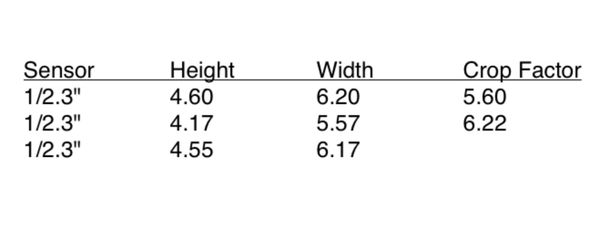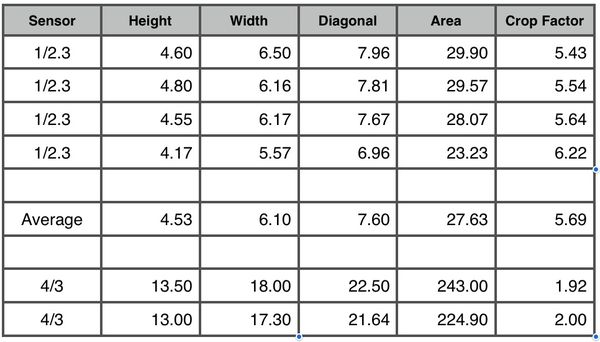Sensor size in point and shoots?
Jun 2, 2014 13:34:07 #
amehta
Loc: Boston
Racmanaz wrote:
I am having trouble understanding what exactly is the what 1/2.3" CMOS is??? How do you interpret that number fraction? is it a 1/2 inch plus .3 inches??? what is it and why don't they use the metric system for sensor sizes as they do with other camera measurements???
I believe that sensor size should be read as "(1 divided by 2.3) inches". This means that 1/2.3=0.43 is smaller than 1/1.7=0.59.
As others have said, those were ways to describe tubes used in TV studio cameras.
They do not use metric system for sensor sizes because they don't want people to think about the sensor size. Keeping it cryptic makes it easier for people to ignore it.
Jun 2, 2014 13:39:42 #
Racmanaz wrote:
Lol and I have yet to get the answer I need.
don't feel bad i have yet to see the answer either
Jun 2, 2014 13:42:26 #
Racmanaz wrote:
I am having trouble understanding what exactly is the what 1/2.3" CMOS is??? How do you interpret that number fraction? is it a 1/2 inch plus .3 inches??? what is it and why don't they use the metric system for sensor sizes as they do with other camera measurements???
A sensor designated 1/2.3" is a sensor with a 4:3 aspect ration. It has a diameter of 11.004mm, measures 7.70mm diagonally, is 6.16mm wide, and 4.8mm high. Why is it called 1/2.3"? It goes back to TV of the 1950's. See below.
"Sensors are often referred to with a "type" designation using imperial fractions such as 1/1.8" or 2/3" which are larger than the actual sensor diameters. The type designation harks back to a set of standard sizes given to TV camera tubes in the 50's. These sizes were typically 1/2", 2/3" etc. The size designation does not define the diagonal of the sensor area but rather the outer diameter of the long glass envelope of the tube. Engineers soon discovered that for various reasons the usable area of this imaging plane was approximately two thirds of the designated size. This designation has clearly stuck (although it should have been thrown out long ago). There appears to be no specific mathematical relationship between the diameter of the imaging circle and the sensor size, although it is always roughly two thirds."
CMOS stands for complementary metal oxide semiconductor. That and the CCD were developed in the '60's and 70's, but the CCD because more popular with manufacturers. Lately, CMOS is used in more devices, although each has advantages and disadvantages.
Jun 2, 2014 13:43:12 #
The sensor size is a fraction of the full size 35mm sensor.But they don't call it that exactly. That's why it's confusing. Each lens used on a given sensor needs to be focused on that size. Sooo it needs to be multiplied by a conversion factor. You can't get all of what would fit on a full frame image on a dx or smaller sensor-sooo it makes the lens used equivalent to a larger lens-or multiplies it in size-so a 50mm lens on a canon 3ti rebel becomes 1.6 longer or larger or a 75+ lens. That's how the sensor size and lenses interrelate. Maybe that will totally confuse but hope it helps some.
Jun 2, 2014 16:30:59 #
oldtigger wrote:
don't feel bad i have yet to see the answer either
The answer is there is no answer. I research the size of a 1/2.3 sensor on line and got three different answers. Nobody knows for sure what they're doing and there is no I.O.S. (that's not ISO) standard!
Jun 2, 2014 16:33:22 #
Mogul wrote:
The answer is there is no answer. I research the size of a 1/2.3 sensor on line and got three different answers. Nobody knows for sure what they're doing and there is no I.O.S. (that's not ISO) standard!
you can add 6.16mm and 4.8mm to that list according to jerryc41
Jun 2, 2014 16:42:35 #
oldtigger wrote:
you can add 6.16mm and 4.8mm to that list according to jerryc41
Yeah, but Jerry already had that listed and why duplicate. Hmmmm, I think I will take that old junker I have in my trunk and cut the sensor to a new 1/2.3!
Jun 2, 2014 18:06:19 #
Jun 2, 2014 21:22:34 #
jerryc41 wrote:
A sensor designated 1/2.3" is a sensor with a... (show quote)
When confronted with the choice, the CMOS device far exceed the older CCD device all the time. Older CCD sensors can get washed out over time and any outside magnetic field can seriously alter the image captured. Also, I think you'll find that the CMOS sensors can implement far more photo cells in the same area and have far better color accuracy.
And to be more precise, the designation of CCD actually stands for "CHARGE COUPLED DEVICE" for photo sensors.
Jun 2, 2014 21:31:19 #
Racmanaz
Loc: Sunny Tucson!
I think Amehta has the answer I am looking for, thanks for that answer....now it's more clear to me. :)
Jun 2, 2014 21:42:28 #
Racmanaz wrote:
I think Amehta has the answer I am looking for, thanks for that answer....now it's more clear to me. :)
Also keep in mind that the more individual photo cells you put in a specific area, the lower the light captured for any one cell. YES, you can make 36 MP photo sensors in the micro 4/3 size, but then it will be horrible for anything over 400 ISO and have huge amounts of noise. The larger the bucket, the more light that's captured so there is some balance between sensor size and number of pixels.
Jun 2, 2014 21:59:35 #
Racmanaz
Loc: Sunny Tucson!
singleviking wrote:
Also keep in mind that the more individual photo cells you put in a specific area, the lower the light captured for any one cell. YES, you can make 36 MP photo sensors in the micro 4/3 size, but then it will be horrible for anything over 400 ISO and have huge amounts of noise. The larger the bucket, the more light that's captured so there is some balance between sensor size and number of pixels.
I agree, that's why I see such beautiful image quality from the Nikon D90 with 12 mps.
Jun 2, 2014 22:07:36 #
Racmanaz wrote:
I agree, that's why I see such beautiful image quality from the Nikon D90 with 12 mps.
Well, recent improvement in DSP and camera processing programs have sure made the reduction of noise easier and many of the small and micro photo sensors automatically use noise reduction routines in their DSP programs. But then they only capture JPEG files. This is how many companies can advertise 16 or 20 mp sensors in their point & shoots or 40 mp in their SMARTPHONES when still using such small sensors.
Jun 3, 2014 04:23:27 #
Mogul wrote:
The answer is there is no answer. I research the size of a 1/2.3 sensor on line and got three different answers. Nobody knows for sure what they're doing and there is no I.O.S. (that's not ISO) standard!
So, I sez to meself, "Self (that's what I call me), why not take this whole mish-mash of data and do it up right?" And I answered, "I can do that!" So I takes meself to me computator and I builds me a spreadsheet - and here 'tis:
Please note that, for the 4/3, the top is the sensor and the bottom is the image size.
Jun 3, 2014 07:04:27 #
Mogul wrote:
So, I sez to meself, "Self (that's what I call me), why not take this whole mish-mash of data and do it up right?" And I answered, "I can do that!" So I takes meself to me computator and I builds me a spreadsheet - and here 'tis:
Please note that, for the 4/3, the top is the sensor and the bottom is the image size.
Please note that, for the 4/3, the top is the sensor and the bottom is the image size.
lol, thanks to your in depth search Mogul we can be reasonably certain that a 1/2.3 sensor is smaller than a bread basket but bigger than a gnats ass.
If you want to reply, then register here. Registration is free and your account is created instantly, so you can post right away.





